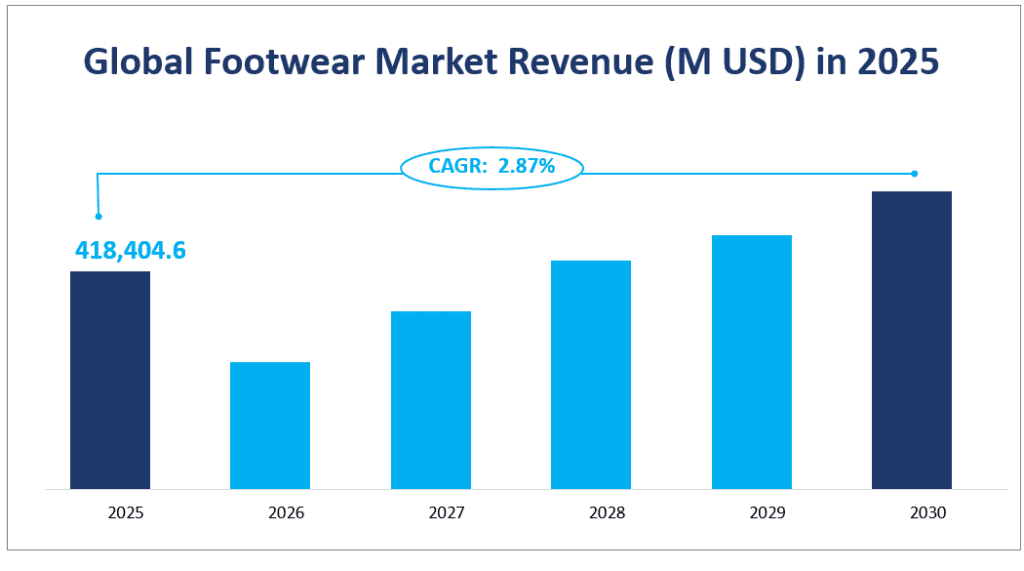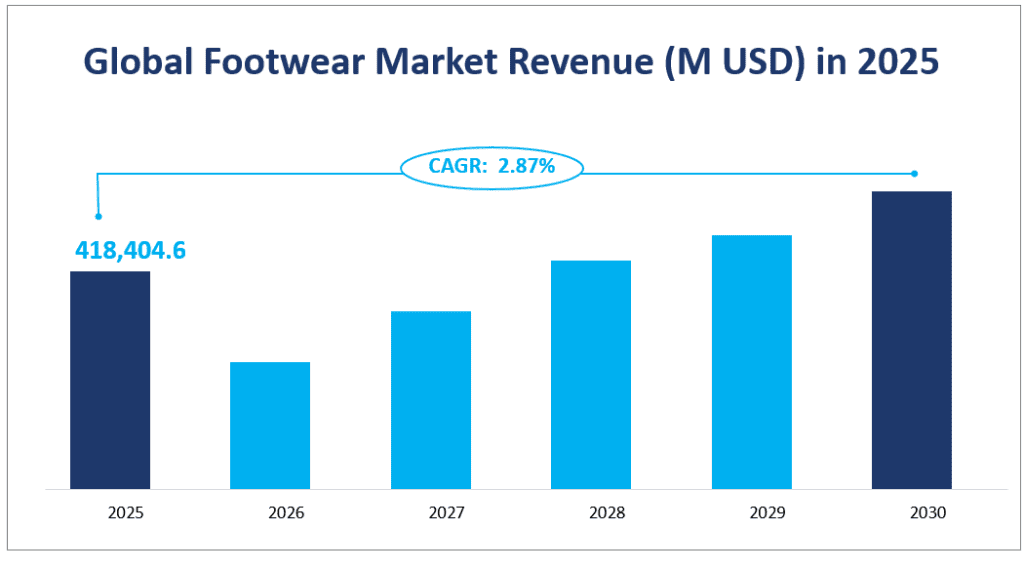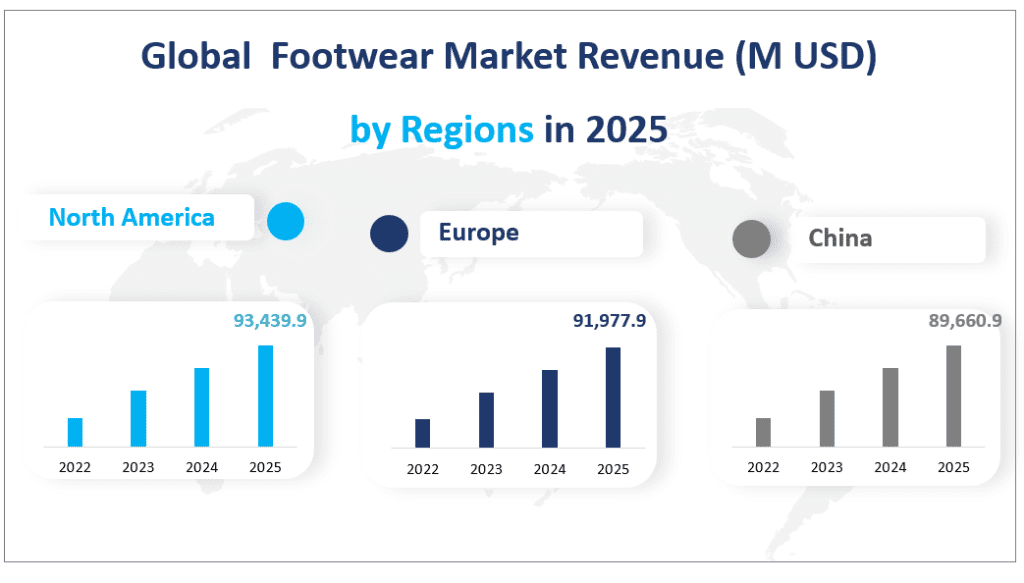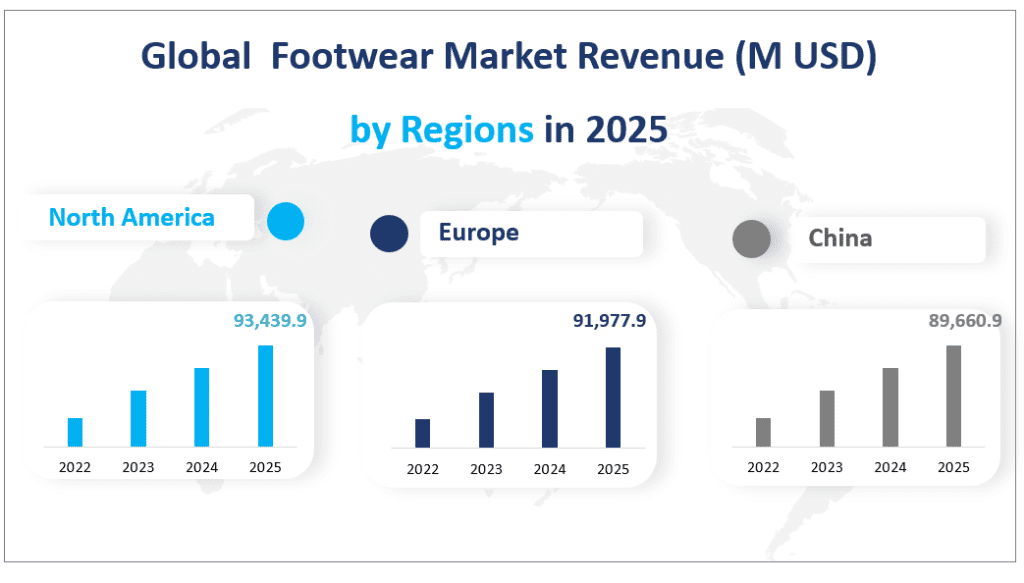1. Global Footwear Market Analysis
In 2025, the global footwear market is projected to generate a revenue of approximately $418,404.6 million with a CAGR of 2.87% from 2025 to 2030. This growth rate underscores the market’s resilience and potential for expansion despite economic fluctuations and changing consumer preferences.
The footwear market is defined as the global industry involved in the design, manufacturing, and distribution of various types of shoes. This includes athletic footwear, casual and formal shoes, as well as specialized footwear for different activities and climates. The market is segmented by type, application, and region, with each segment catering to specific consumer needs and preferences. For instance, athletic footwear is designed for sports and physical activities, while casual and formal shoes are tailored for everyday wear and professional settings. The market also includes seasonal and weather-specific footwear, such as winter boots and summer sandals. The diverse range of products within the footwear market reflects the industry’s adaptability to different lifestyles and environmental conditions.
Global Footwear Market Revenue (M USD) in 2025


2. Driving Factors of the Footwear Market
Rising disposable incomes in emerging economies, particularly in Asia and Latin America, have increased consumer spending on non-essential items, including high-quality and branded footwear. This trend is especially evident in countries like China and India, where rapid economic growth has led to a burgeoning middle class with a higher propensity to spend on fashion and comfort.
Another significant driver is the growing demand for athletic footwear. The increasing awareness of health and fitness benefits, combined with the rising popularity of sports and physical activities, has fueled the demand for specialized athletic shoes. Major sporting events, such as the Olympics and the FIFA World Cup, further boost the market by generating consumer interest and demand for branded athletic footwear.
E-commerce has also played a crucial role in expanding the footwear market. Online platforms offer consumers a broader range of choices, competitive prices, and the convenience of shopping from home. The growth of e-commerce has enabled footwear brands to reach a wider audience, particularly in regions with limited physical retail presence.
3. Limiting Factors of the Footwear Market Growth
Despite its growth potential, the footwear market faces several challenges. The presence of counterfeit products poses a significant threat to legitimate businesses. Counterfeit footwear not only reduces market share but also damages brand reputation and consumer trust.
Fluctuating raw material prices, such as leather, rubber, and plastics, also impact the market. These materials are essential for footwear production, and their price volatility can strain manufacturers’ profit margins. Additionally, the footwear industry is highly competitive, with established brands engaging in intense price wars to capture market share. This competition can limit the profitability of smaller players and hinder overall market growth.
Inflationary pressures further complicate the market dynamics. Rising costs of production, labor, and transportation are often passed on to consumers, potentially reducing demand. Additionally, high inflation rates can erode consumer purchasing power, leading to a decline in overall footwear spending.
4. Analysis of the Global Footwear Market Segment
Product Types
Among these categories, Comfort Shoes (excluding Sandals/Heels) and Boat Shoes/Moccasins are the most prominent, with a market value of $31808.6 million and $30414.3 million in 2025 respectively. Comfort shoes are designed for maximum comfort and support, making them popular among consumers who prioritize functionality and durability. These shoes often feature cushioning, arch support, and flexibility, making them suitable for everyday wear and various activities.
Boat Shoes/Moccasins, on the other hand, are characterized by their casual style and versatility. These shoes are typically made from leather or suede and are known for their non-slip rubber soles. Their popularity stems from their ability to provide comfort and style, making them a favorite for both casual and semi-formal occasions.
While Comfort Shoes (excluding Sandals/Heels) hold the largest market share, the fastest-growing segment in terms of market revenue is Comfort Sandals. The growth of comfort sandals can be attributed to the increasing demand for casual footwear that offers both style and comfort. Consumers are increasingly looking for sandals that provide arch support and cushioning, making them suitable for extended periods of wear.
Applications of the Footwear Market
Among these applications, the Male segment holds the largest market share, accounting for nearly 47.52% of the total market revenue. This segment includes a wide range of footwear designed specifically for men, such as walking shoes, sneakers, loafers, and boots. The demand for male footwear is driven by factors such as fashion trends, seasonal changes, and the need for durable and comfortable shoes for various activities.
Despite the larger market share of the Male segment, the Unisex application is experiencing the fastest growth rate. The unisex segment is expected to grow at a rate of 3.31% annually from 2024 to 2029. The growth of unisex footwear can be attributed to the increasing popularity of gender-neutral fashion trends. Consumers are increasingly looking for footwear that is versatile and can be worn by both men and women. This trend is particularly evident in casual and athletic footwear, where unisex designs offer a broader appeal and greater flexibility in styling.
Market Revenue and Share by Segment
| Market Revenue (M USD) in 2025 | Market Share in 2025 | ||
| By Type | Comfort Shoes (excluding Sandals/Heels) | 31,808.6 | 7.60% |
| Comfort Sandals | 26,181.7 | 6.26% | |
| Boat Shoes/Moccasins | 30,414.3 | 7.27% | |
| Winter/Summer/Transitional/All Year Shoes | 21,841.3 | 5.22% | |
| Comfort Heels | 3,295.3 | 0.79% | |
| Others | 304863.3 | 72.86% | |
| By Application | Male | 198,807.0 | 47.52% |
| Female | 164,050.5 | 39.21% | |
| Unisex | 54,371.8 | 13.00% |
5. Regional Footwear Market:
North America, comprising the United States and Canada, is a major player in the global footwear market. In 2025, the region is expected to generate a revenue of $93,439.9 million. The United States alone accounts for a significant portion of this revenue, driven by a diverse consumer base and a strong preference for both athletic and casual footwear. The market in North America is characterized by high consumer spending power and a focus on fashion and comfort.
Europe remains a key market for footwear, with a projected revenue of $91,977.9 million in 2025. The region is known for its high-quality leather goods and luxury brands, which attract consumers globally. Countries like Italy and France are particularly renowned for their craftsmanship and design excellence. The European market is driven by fashion trends, seasonal changes, and a growing demand for sustainable and eco-friendly products.
China is the largest and fastest-growing market for footwear, with a projected revenue of $89,660.9 million in 2025, with large population and rapidly expanding middle classes. The region’s market is characterized by a mix of high-end luxury brands and affordable, mass-market products. The increasing disposable incomes and urbanization in countries like China and India are fueling the demand for both casual and formal footwear.
Latin America is another significant region in the global footwear market, with a projected revenue of $31,884.6 million in 2025. The region’s market is driven by a growing middle class and a strong demand for both casual and formal footwear. Brazil and Mexico are the major markets in this region, with a focus on stylish and comfortable products. The region is also known for its vibrant fashion culture and a growing interest in sustainable and eco-friendly footwear.
The Middle East and Africa region is projected to generate a revenue of $29,948.5 million in 2025. The region’s market is characterized by a mix of traditional and modern footwear, with a strong demand for luxury brands and high-quality products. The Gulf Cooperation Council (GCC) countries, in particular, are driving the demand for premium footwear. The region’s market is also influenced by cultural preferences and a growing interest in sustainable and eco-friendly products.
Global Footwear Market Revenue (M USD) by Regions in 2025


6. Analysis of the Top 3 Companies in the Footwear Market
Company Introduction and Business Overview:
Birkenstock is a renowned German footwear brand, established in 1774. The company is known for its high-quality, comfortable, and eco-friendly footwear. Birkenstock’s products are designed to provide maximum comfort and support, making them popular among consumers worldwide. The brand is particularly famous for its iconic sandals and comfort shoes.
Products Offered:
Birkenstock offers a wide range of footwear, including sandals, comfort shoes, and casual footwear. Their products are characterized by features such as anatomically shaped cork-latex footbeds, breathable materials, and adjustable straps. Some of their popular products include the Arizona sandal and the Boston clog.
Company Introduction and Business Overview:
ECCO is a leading Danish footwear company, established in 1963. The company is known for its high-quality leather goods and innovative footwear designs. ECCO’s products combine style and comfort, making them popular among consumers worldwide. The company owns and manages every aspect of the value chain, from leather and shoe manufacturing to wholesale and retail activities.
Products Offered:
ECCO offers a wide range of footwear, including casual shoes, sneakers, and formal footwear. Their products are characterized by features such as high-quality leathers, innovative technologies, and sustainable materials. Some of their popular products include the ECCO Street Ace Sneaker and the ECCO Biom C Golf Shoe.
Company Introduction and Business Overview:
Rieker is a Swiss footwear company, established in 1874. The company is known for its high-quality, comfortable, and stylish footwear. Rieker’s products are designed to provide maximum comfort and support, making them popular among consumers worldwide. The company’s commitment to quality and style has ensured its continuous growth for over 150 years.
Products Offered:
Rieker offers a wide range of footwear, including casual shoes, boots, and sandals. Their products are characterized by features such as synthetic leather, shock-absorbing soles, and adjustable straps. Some of their popular products include the Rieker 68191 Rose and the Rieker 68201 Black.
Major Players
| Company Name | Headquarter | Sales Region |
| Birkenstock | Germany | Worldwide |
| ECCO | Denmark | Worldwide |
| Rieker | Switzerland | Mainly in Europe, North America |
| Geox | Italy | Worldwide |
| Cole Haan | USA | Worldwide |
| ara Shoes | Germany | Worldwide |
| Mephisto | France | Worldwide |
| Gabor Shoes | Germany | Mainly in Europe, APAC, North America |
| Vionic Group (Caleres) | USA | Mainly in North America |
| Aetrex | USA | Worldwide |
| Dansko | USA | Mainly in North America, Europe, APAC |
| Josef Seibel | Germany | Worldwide |
| Pikolinos | Spain | Mainly in Europe |
| Earth (Marc Fisher) | USA | Mainly in North America |
| Ziera Shoes | Australia | Mainly in APAC, North America |
| FRANKIE4 | Australia | Mainly in APAC, North America |
| Taos Footwear | USA | Mainly in North America |
| Marion Parke | USA | Mainly in North America, Europe |
| Sarah Flint | USA | Mainly in North America, Europe |
| Ron White Shoes | Canada | Mainly in North America |
Chapter 1: Footwear Market Overview
1.1 Product Overview and Scope of Footwear Market
1.2 Footwear Market Segment by Type
1.2.1 Global Footwear Market Sales Volume and CAGR (%) Comparison by Type (2019-2029)
1.2.2 The Market Profile of Comfort Shoes (excl. Sandals/Heels)
1.2.3 The Market Profile of Comfort Sandals
1.2.4 The Market Profile of Boat shoes/Moccasins
1.2.5 The Market Profile of Winter/Summer/Transitional/All Year Shoes
1.2.6 The Market Profile of Comfort Heels
1.3 Global Footwear Market Segment by Application
1.3.1 Footwear Market Sales Volume Comparison by Application (2019-2029)
1.3.2 The Market Profile of Male
1.3.3 The Market Profile of Female
1.3.4 The Market Profile of Unisex
1.4 Global Footwear Market, Region Wise (2019-2029)
1.4.1 Global Footwear Market Size (Revenue) and CAGR (%) Comparison by Region (2019-2029)
1.4.2 United States Footwear Market Status and Prospect (2019-2029)
1.4.3 Europe Footwear Market Status and Prospect (2019-2029)
1.4.4 China Footwear Market Status and Prospect (2019-2029)
1.4.5 Japan Footwear Market Status and Prospect (2019-2029)
1.4.6 India Footwear Market Status and Prospect (2019-2029)
1.4.7 Southeast Asia Footwear Market Status and Prospect (2019-2029)
1.4.8 Latin America Footwear Market Status and Prospect (2019-2029)
1.4.9 Middle East and Africa Footwear Market Status and Prospect (2019-2029)
1.4.10 Australia Footwear Market Status and Prospect (2019-2029)
1.4.11 Canada Footwear Market Status and Prospect (2019-2029)
1.5 Global Market Size of Footwear (2019-2029)
1.5.1 Global Footwear Market Revenue Status and Outlook (2019-2029)
1.5.2 Global Footwear Market Sales Volume Status and Outlook (2019-2029)
1.6 Global Macroeconomic Analysis
1.7 Global Footwear Revenue and Market Share by Price (2019-2029)
1.8 Global Footwear Revenue and Market Share by Age (2019-2029)
Chapter 2: Industry Outlook
2.1 Footwear Industry Technology Status and Trends
2.2 Industry Entry Barriers
2.2.1 Analysis of Financial Barriers
2.2.2 Analysis of Technical Barriers
2.2.3 Analysis of Talent Barriers
2.2.4 Analysis of Brand Barrier
2.3 Footwear Market Drivers Analysis
2.4 Footwear Market Challenges Analysis
2.5 Emerging Market Trends
2.6 Consumer Preference Analysis
2.7 The Impact of Regional Situation on Footwear Industries
2.8 The Impact of Inflation on Footwear Industries
2.9 The Transformative Power of AI on Footwear Industries
2.10 Economic Development in an Era of Climate Change
Chapter 3: Global Footwear Market Landscape by Player
3.1 Global Footwear Sales Volume and Share by Player (2019-2024)
3.2 Global Footwear Revenue and Market Share by Player (2019-2024)
3.3 Global Footwear Average Price by Player (2019-2024)
3.4 Global Footwear Gross Margin by Player (2019-2024)
3.5 Footwear Market Competitive Situation and Trends
3.5.1 Footwear Market Concentration Rate
3.5.2 Footwear Market Share of Top 3 and Top 6 Players
3.5.3 Mergers & Acquisitions, Expansion
Chapter 4: Global Footwear Sales Volume and Revenue Region Wise (2019-2024)
4.1 Global Footwear Sales Volume and Market Share, Region Wise (2019-2024)
4.2 Global Footwear Revenue and Market Share, Region Wise (2019-2024)
4.3 Global Footwear Sales Volume, Revenue, Price and Gross Margin (2019-2024)
4.4 United States Footwear Sales Volume, Revenue, Price and Gross Margin (2019-2024)
4.4.1 West USA Footwear Sales Volume, Revenue, Price and Gross Margin (2019-2024)
4.4.2 South USA Footwear Sales Volume, Revenue, Price and Gross Margin (2019-2024)
4.4.3 Middle West USA Footwear Sales Volume, Revenue, Price and Gross Margin (2019-2024)
4.4.4 Northeast USA Footwear Sales Volume, Revenue, Price and Gross Margin (2019-2024)
4.5 Europe Footwear Sales Volume, Revenue, Price and Gross Margin (2019-2024)
4.6 China Footwear Sales Volume, Revenue, Price and Gross Margin (2019-2024)
4.7 Japan Footwear Sales Volume, Revenue, Price and Gross Margin (2019-2024)
4.8 India Footwear Sales Volume, Revenue, Price and Gross Margin (2019-2024)
4.9 Southeast Asia Footwear Sales Volume, Revenue, Price and Gross Margin (2019-2024)
4.10 Latin America Footwear Sales Volume, Revenue, Price and Gross Margin (2019-2024)
4.11 Middle East and Africa Footwear Sales Volume, Revenue, Price and Gross Margin (2019-2024)
4.12 Australia Footwear Sales Volume, Revenue, Price and Gross Margin (2019-2024)
4.13 Canada Footwear Sales Volume, Revenue, Price and Gross Margin (2019-2024)
Chapter 5: Global Footwear Sales Volume, Revenue, Price Trend by Type
5.1 Global Footwear Sales Volume and Market Share by Type (2019-2024)
5.2 Global Footwear Revenue and Market Share by Type (2019-2024)
5.3 Global Footwear Price by Type (2019-2024)
5.4 Global Footwear Sales Volume, Revenue and Growth Rate by Type (2019-2024)
5.4.1 Global Footwear Sales Volume, Revenue and Growth Rate of Comfort Shoes (excl. Sandals/Heels) (2019-2024)
5.4.2 Global Footwear Sales Volume, Revenue and Growth Rate of Comfort Sandals (2019-2024)
5.4.3 Global Footwear Sales Volume, Revenue and Growth Rate of Boat shoes/Moccasins (2019-2024)
5.4.4 Global Footwear Sales Volume, Revenue and Growth Rate of Winter/Summer/Transitional/All Year Shoes (2019-2024)
5.4.5 Global Footwear Sales Volume, Revenue and Growth Rate of Comfort Heels (2019-2024)
Chapter 6: Global Footwear Market Analysis by Application
6.1 Global Footwear Sales Volume and Market Share by Application (2019-2024)
6.2 Global Footwear Revenue and Market Share by Application (2019-2024)
6.3 Global Footwear Sales Volume and Growth Rate by Application (2019-2024)
6.3.1 Global Footwear Sales Volume and Growth Rate of Male (2019-2024)
6.3.2 Global Footwear Sales Volume and Growth Rate of Female (2019-2024)
6.3.3 Global Footwear Sales Volume and Growth Rate of Unisex (2019-2024)
Chapter 7: Global Footwear Market Forecast (2024-2029)
7.1 Global Footwear Sales Volume, Revenue Forecast (2024-2029)
7.1.1 Global Footwear Sales Volume and Growth Rate Forecast (2024-2029)
7.1.2 Global Footwear Revenue and Growth Rate Forecast (2024-2029)
7.1.3 Global Footwear Price and Trend Forecast (2024-2029)
7.2 Global Footwear Sales Volume and Revenue Forecast, Region Wise (2024-2029)
7.2.1 United States Footwear Sales Volume and Revenue Forecast (2024-2029)
7.2.2 Europe Footwear Sales Volume and Revenue Forecast (2024-2029)
7.2.3 China Footwear Sales Volume and Revenue Forecast (2024-2029)
7.2.4 Japan Footwear Sales Volume and Revenue Forecast (2024-2029)
7.2.5 India Footwear Sales Volume and Revenue Forecast (2024-2029)
7.2.6 Southeast Asia Footwear Sales Volume and Revenue Forecast (2024-2029)
7.2.7 Latin America Footwear Sales Volume and Revenue Forecast (2024-2029)
7.2.8 Middle East and Africa Footwear Sales Volume and Revenue Forecast (2024-2029)
7.2.9 Australia Footwear Sales Volume and Revenue Forecast (2024-2029)
7.2.10 Canada Footwear Sales Volume and Revenue Forecast (2024-2029)
7.3 Global Footwear Sales Volume, Revenue and Price Forecast by Type (2024-2029)
7.3.1 Global Footwear Revenue and Growth Rate of Comfort Shoes (excl. Sandals/Heels) (2024-2029)
7.3.2 Global Footwear Revenue and Growth Rate of Comfort Sandals (2024-2029)
7.3.3 Global Footwear Revenue and Growth Rate of Boat shoes/Moccasins (2024-2029)
7.3.4 Global Footwear Revenue and Growth Rate of Winter/Summer/Transitional/All Year Shoes (2024-2029)
7.3.5 Global Footwear Revenue and Growth Rate of Comfort Heels (2024-2029)
7.4 Global Footwear Sales Volume Forecast by Application (2024-2029)
7.4.1 Global Footwear Revenue and Growth Rate of Male (2024-2029)
7.4.2 Global Footwear Revenue and Growth Rate of Female (2024-2029)
7.4.3 Global Footwear Revenue and Growth Rate of Unisex (2024-2029)
Chapter 8: Footwear Market Upstream and Downstream Analysis
8.1 Footwear Industrial Chain Analysis
8.2 Key Raw Materials Suppliers and Price Analysis
8.3 Manufacturing Cost Structure Analysis
8.3.1 Labor Cost Analysis
8.3.2 Manufacturing Expenses Analysis
8.4 Major Distributors of Footwear Analysis
Chapter 9: Players Profiles
9.1 Birkenstock
9.1.1 Birkenstock Basic Information
9.1.2 Footwear Product Profiles, Application and Specification
9.1.3 Birkenstock Footwear Market Performance (2019-2024)
9.1.4 Recent Development
9.1.5 Birkenstock Business Overview and Competitive Strength Analysis
9.2 ECCO
9.2.1 ECCO Basic Information
9.2.2 Footwear Product Profiles, Application and Specification
9.2.3 ECCO Footwear Market Performance (2019-2024)
9.2.4 Recent Development
9.2.5 ECCO Business Overview and Competitive Strength Analysis
9.3 Rieker
9.3.1 Rieker Basic Information
9.3.2 Footwear Product Profiles, Application and Specification
9.3.3 Rieker Footwear Market Performance (2019-2024)
9.3.4 Rieker Business Overview and Competitive Strength Analysis
9.4 Geox
9.4.1 Geox Basic Information
9.4.2 Footwear Product Profiles, Application and Specification
9.4.3 Geox Footwear Market Performance (2019-2024)
9.4.4 Recent Development
9.4.5 Geox Business Overview and Competitive Strength Analysis
9.5 Cole Haan
9.5.1 Cole Haan Basic Information
9.5.2 Footwear Product Profiles, Application and Specification
9.5.3 Cole Haan Footwear Market Performance (2019-2024)
9.5.4 Recent Development
9.5.5 Cole Haan Business Overview and Competitive Strength Analysis
9.6 ara Shoes
9.6.1 ara Shoes Basic Information
9.6.2 Footwear Product Profiles, Application and Specification
9.6.3 ara Shoes Footwear Market Performance (2019-2024)
9.6.4 Recent Development
9.6.5 ara Shoes Business Overview and Competitive Strength Analysis
9.7 Mephisto
9.7.1 Mephisto Basic Information
9.7.2 Footwear Product Profiles, Application and Specification
9.7.3 Mephisto Footwear Market Performance (2019-2024)
9.7.4 Mephisto Business Overview and Competitive Strength Analysis
9.8 Gabor Shoes
9.8.1 Gabor Shoes Basic Information
9.8.2 Footwear Product Profiles, Application and Specification
9.8.3 Gabor Shoes Footwear Market Performance (2019-2024)
9.8.4 Gabor Shoes Business Overview and Competitive Strength Analysis
9.9 Vionic Group (Caleres)
9.9.1 Vionic Group (Caleres) Basic Information
9.9.2 Footwear Product Profiles, Application and Specification
9.9.3 Vionic Group (Caleres) Footwear Market Performance (2019-2024)
9.9.4 Vionic Group (Caleres) Business Overview and Competitive Strength Analysis
9.10 Aetrex
9.10.1 Aetrex Basic Information
9.10.2 Footwear Product Profiles, Application and Specification
9.10.3 Aetrex Footwear Market Performance (2019-2024)
9.10.4 Aetrex Business Overview and Competitive Strength Analysis
9.11 Dansko
9.11.1 Dansko Basic Information
9.11.2 Footwear Product Profiles, Application and Specification
9.11.3 Dansko Footwear Market Performance (2019-2024)
9.11.4 Dansko Business Overview and Competitive Strength Analysis
9.12 Josef Seibel
9.12.1 Josef Seibel Basic Information
9.12.2 Footwear Product Profiles, Application and Specification
9.12.3 Josef Seibel Footwear Market Performance (2019-2024)
9.12.4 Josef Seibel Business Overview and Competitive Strength Analysis
9.13 Pikolinos
9.13.1 Pikolinos Basic Information
9.13.2 Footwear Product Profiles, Application and Specification
9.13.3 Pikolinos Footwear Market Performance (2019-2024)
9.13.4 Pikolinos Business Overview and Competitive Strength Analysis
9.14 Earth (Marc Fisher)
9.14.1 Earth (Marc Fisher) Basic Information
9.14.2 Footwear Product Profiles, Application and Specification
9.14.3 Earth (Marc Fisher) Footwear Market Performance (2019-2024)
9.14.4 Earth (Marc Fisher) Business Overview and Competitive Strength Analysis
9.15 Ziera Shoes
9.15.1 Ziera Shoes Basic Information
9.15.2 Footwear Product Profiles, Application and Specification
9.15.3 Ziera Shoes Footwear Market Performance (2019-2024)
9.15.4 Ziera Shoes Business Overview and Competitive Strength Analysis
9.16 FRANKIE4
9.16.1 FRANKIE4 Basic Information
9.16.2 Footwear Product Profiles, Application and Specification
9.16.3 FRANKIE4 Footwear Market Performance (2019-2024)
9.16.4 FRANKIE4 Business Overview and Competitive Strength Analysis
9.17 Taos Footwear
9.17.1 Taos Footwear Basic Information
9.17.2 Footwear Product Profiles, Application and Specification
9.17.3 Taos Footwear Footwear Market Performance (2019-2024)
9.17.4 Taos Footwear Business Overview and Competitive Strength Analysis
9.18 Marion Parke
9.18.1 Marion Parke Basic Information
9.18.2 Footwear Product Profiles, Application and Specification
9.18.3 Marion Parke Footwear Market Performance (2019-2024)
9.18.4 Marion Parke Business Overview and Competitive Strength Analysis
9.19 Sarah Flint
9.19.1 Sarah Flint Basic Information
9.19.2 Footwear Product Profiles, Application and Specification
9.19.3 Sarah Flint Footwear Market Performance (2019-2024)
9.19.4 Sarah Flint Business Overview and Competitive Strength Analysis
9.20 Ron White Shoes
9.20.1 Ron White Shoes Basic Information
9.20.2 Footwear Product Profiles, Application and Specification
9.20.3 Ron White Shoes Footwear Market Performance (2019-2024)
9.20.4 Ron White Shoes Business Overview and Competitive Strength Analysis
Chapter 10: Appendix
10.1 Methodology
10.2 Research Data Source
10.2.1 Secondary Data
10.2.2 Primary Data
10.2.3 Market Size Estimation
10.2.4 Legal Disclaimer
